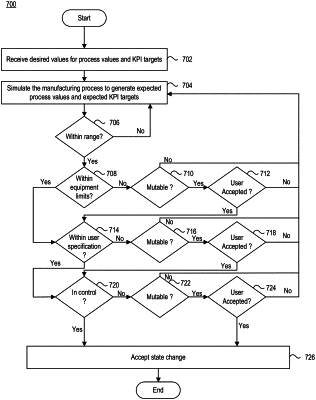| CPC G05B 13/0265 (2013.01) [G05B 13/042 (2013.01)] | 7 Claims |

|
1. A manufacturing system, comprising:
one or more process stations configured to execute a manufacturing process, wherein the manufacturing process comprises an initial set of processing parameters;
a station control system configured to control the one or more process stations; and
a controller in communication with the one or more process stations and the station control system, the controller configured to perform operations comprising:
receiving desired process values associated with the one or more process stations;
receiving desired target values for one or more key performance indicators of the manufacturing process, wherein each key performance indicator of the one or more key performance indicators is a computed value based on one or more intermediate or final output values generated during the manufacturing process;
generating, by a deep learning processor, a proposed state change of at least one processing parameter of the initial set of processing parameters;
simulating, by the deep learning processor, the manufacturing process to generate expected process values and expected target values for the one or more key performance indicators based on the proposed state change;
determining, by the deep learning processor, that the proposed state change is acceptable by:
determining that the expected process values and the expected target values for the one or more key performance indicators are within an acceptable tolerance,
determining that the proposed state change is within equipment limits of the one or more process stations,
determining that the proposed state change is within a user specification, the user specification narrower than the equipment limits, and
determining that the expected process values and the expected target values are in statistical process control; and
responsive to determining that the proposed state change is acceptable:
causing a change to the initial set of processing parameters based on the proposed state change, and
causing the one or more process stations to execute the manufacturing process in accordance the change to the initial set of processing parameters.
|